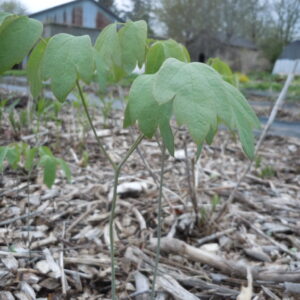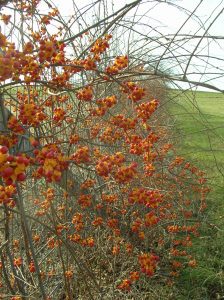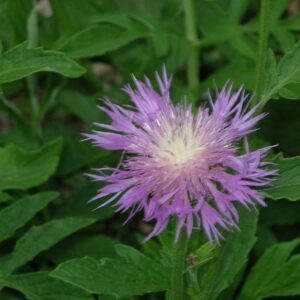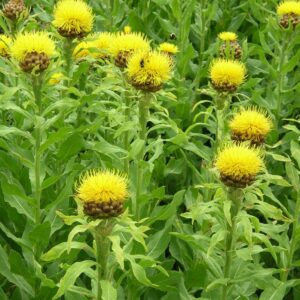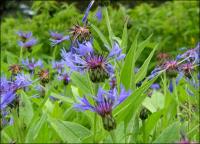Shop
Showing 161–168 of 788 results
-
Catanache caerulea Cupid’s dart Z 4-8
July – September violet cornflower-like flowers with rectangular petals fringed at the ends with deep purple centers.
ARCHIVED
Note: This is a plant not currently for sale. This is an archive page preserved for informational use.
July – September violet cornflower-like flowers with rectangular petals fringed at the ends with deep purple centers.
Size: 16-18” x 8-12”
Care: sun in moist well-drained soil
Native: MediterraneanAn aphrodisiac in ancient Greece. The genus name is adapted from the Greek name for this plant, Katananke which means “forced down against choice” or “compulsion,” as it was believed to be the date rape drug of its day. It is called Cupid’s dart even now because Greeks & Romans used the plant into food of an object of affection. However, it has no actual effect, except perhaps belief in a myth.
-
Caulophyllum thalictroides Blue cohosh Z 3-8
Glaucous blue-green leaves can be mistaken for meadowrue. Blue-berried seeds in fall are its highlight.
ARCHIVED
Note: This is a plant not currently for sale. This is an archive page preserved for informational use.
Glaucous blue-green leaves can be mistaken for meadowrue. Blue-berried seeds in fall are its highlight.
Size: 12-18” x 6-12”
Care: part shade to shade in moist to moist well-drained soil, slightly acidic.
Native: New England, Tennessee & Arkansas
Wildlife Value: its nectar and pollen feed small bees and bumblebees. Deer and rabbit resistantCollected by French planthunter André Michaux before 1800.
-
Ceanothus americanus New Jersey tea, Ping-pong tea Z 4-8
Compact, dense shrub bearing bright green leaves and billowing clusters of fragrant white flowers above the foliage in late spring and early summer.
ARCHIVED
Note: This is a plant not currently for sale. This is an archive page preserved for informational use.
Compact, dense shrub bearing bright green leaves and billowing clusters of fragrant white flowers above the foliage in late spring and early summer.
Size: 3-4’ x 3-5’
Care: full sun in fertile, well-drained soil
Native: eastern North America, Wisconsin native
Wildlife Value: Host for Spring Azure, Summer Azure, Mottled Duskywing butterflies. Birds eat the Seeds. Supports over 30 bee species.Native Americans used Ceanothus americanus to wash injured feet and to cure toothaches, constipation and short breath. Sent to England around 1715 by Mark Catesby, English naturalist. Leaves used extensively to make tea during the American Revolution. Twigs made a cinnamon-colored dye. Cherokee cooked a medicinal tea from the roots to cure toothaches and stomach ailments. Jefferson grew this as part of a shrubbery west of the house at Monticello in 1771.
-
Celastrus scandens Bittersweet, Staff vine VINE Z 4-8
Conspicuous orange fruit in autumn, persisting into winter on the females of this vigorous, native vine
ARCHIVED
Note: This is a plant not currently for sale. This is an archive page preserved for informational use.
Conspicuous orange fruit in autumn, persisting into winter on the females of this vigorous native vine.
Size: 20-30' x 6'
Care: full sun to part shade in any soil except wet. Prune by cutting back fruiting branches in late winter and pinch back branches throughout summer.
Native: Eastern half of North America west to South Dakota and south to New Mexico, Wisconsin nativeName Celastrus derived from Greek “kelastros”. In the mid-1800’s an ointment made from a half pound of Bittersweet root bark simmered with one pound of lard remedied “swelled breasts, discuss or drive away tumors or swellings and also for piles.” Cherokee drank a tea for stomach ailments, chewed the root to cure coughs and washed away bad smells with Bittersweet. HoChunk included the root in a compound to cure colds. 1st collected by Rev. John Banister who moved to colonial Virginia in 1678. A gunman mistakenly shot and killed him while he collected plants. For sale in Bartram Garden’s 1783 Broadside, America’s 1st plant catalog.
-
Centaurea atropurpurea Red knapweed Z 5-9
Ruby-red to merlot, soft thistle-like blooms June-August, if deadheaded, atop silvery, deep cut foliage, rare.
OUT OF STOCK
Ruby-red to merlot, soft thistle-like blooms June-August, repeating if deadheaded, atop silvery, deep cut foliage, rare.
Size: 4’ x 2’
Care: sun in moist well-drained to well-drained soil
Native: meadows of Carpathian mountains
Wildlife Value: Deer resistantCentaurea named for the Centaur, half-horse and half-man who was a mythical healer. Red knapweed described by French entomologist Guillaume Antoine Olivier (1756-1814). Grown at America’s 1st botanic garden, Elgin Botanic Garden 1811.
-
Centaurea dealbata Persian cornflower Z 3-8
Rosy dome shaped blossoms with fringed petals May-June, deadhead for rebloom
Rosy dome shaped blossoms with fringed petals May-June, deadhead for rebloom
Size: 2-3' x 2'
Care: sun in moist well-drained soil
Native: CaucasusNamed for the Centaur, half-horse and half-man who was a mythical famous healer. This species collected before 1803.
-
Centaurea macrocephala Armenian basketflower, Globe centaurea Z 3-9
Picture a Canada thistle at its peak –this looks like a magnificent, cheerful yellow version – but it’s not a thistle July-August.
Picture a Canada thistle at its peak -this looks like a magnificent, cheerful yellow version – but it’s not a thistle. July-August
Can not ship to: Maryland and Washington
Size: 3-4' x 18-24"
Care: sun in well-drained to moist well-drained soil
Native: CaucasusCentaurea is named after the Greek mythological figure a Centaur named Chiron, half-horse, half-man. Macrocephala means “big-head” referring to the big flowers. Philadelphia nurseryman McMahon sent this to Jefferson in 1812.
-
Centaurea montana Mountain bluet, Blue bottle, Bachelor’s button Z 3-8
True blue, with a touch of pink near the center, spidery flowerheads in May-June and sporadically thereafter or all summer if you deadhead.
True blue, with a touch of pink near the center, spidery flowerheads in May-June and sporatically thereafter or all summer if you deadhead.
Size: 18" x 24"
Care: Sun - part shade, moist well-drained soil.
Native: Mountains of EuropeCentaurea is named after the Greek mythological figure, a Centaur named Chiron, half-horse, half-man. Ovid claimed that the plant cured a wound in Chiron’s foot from an arrow hurled by Hercules. Introduced from the Pyrenees and grown in English cottage gardens since the 1500’s.


